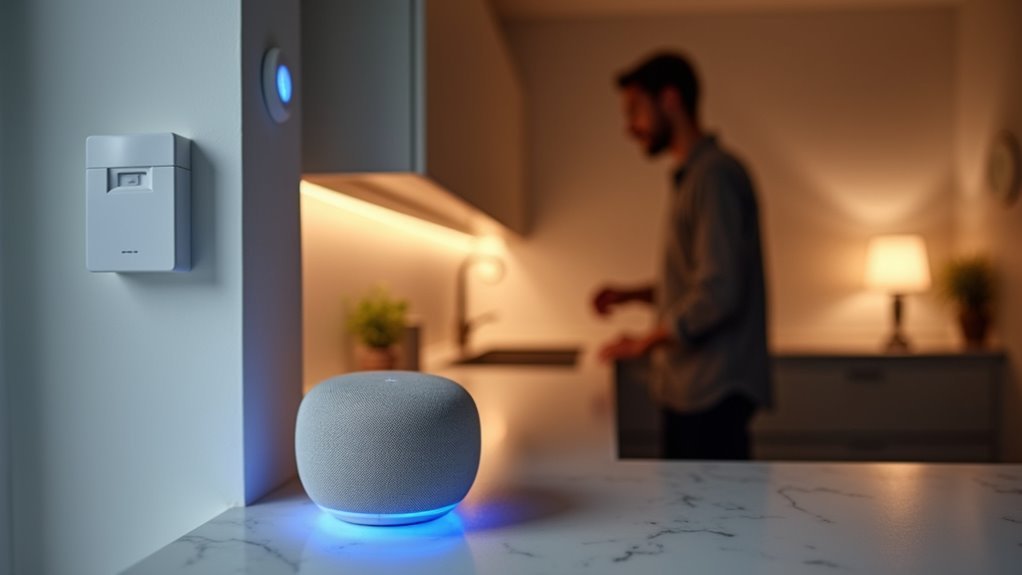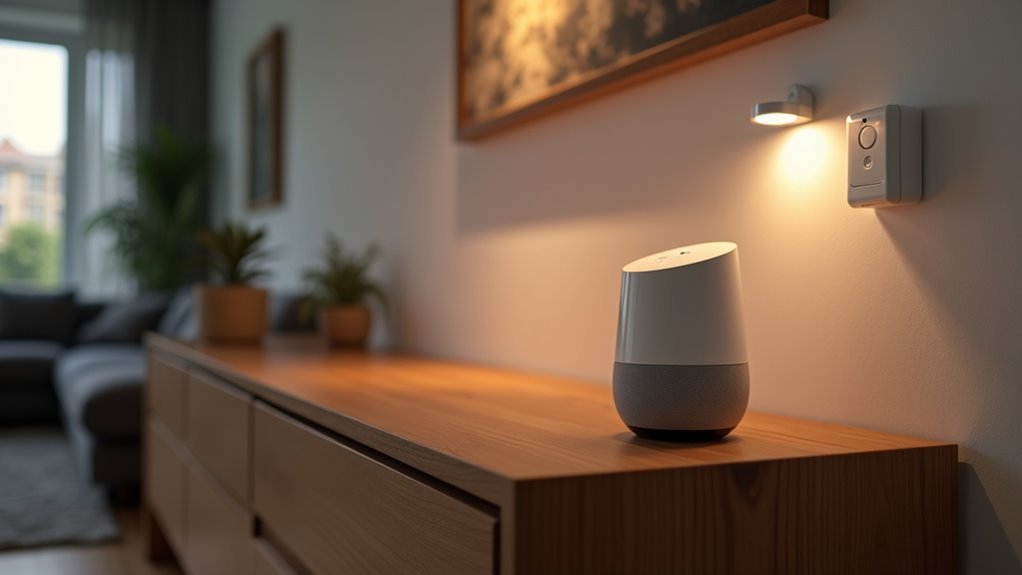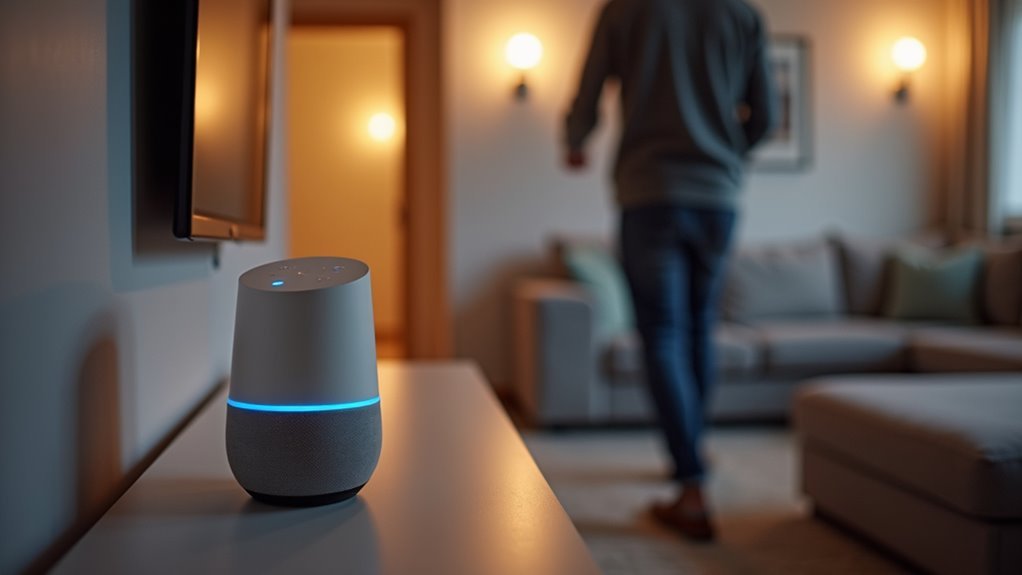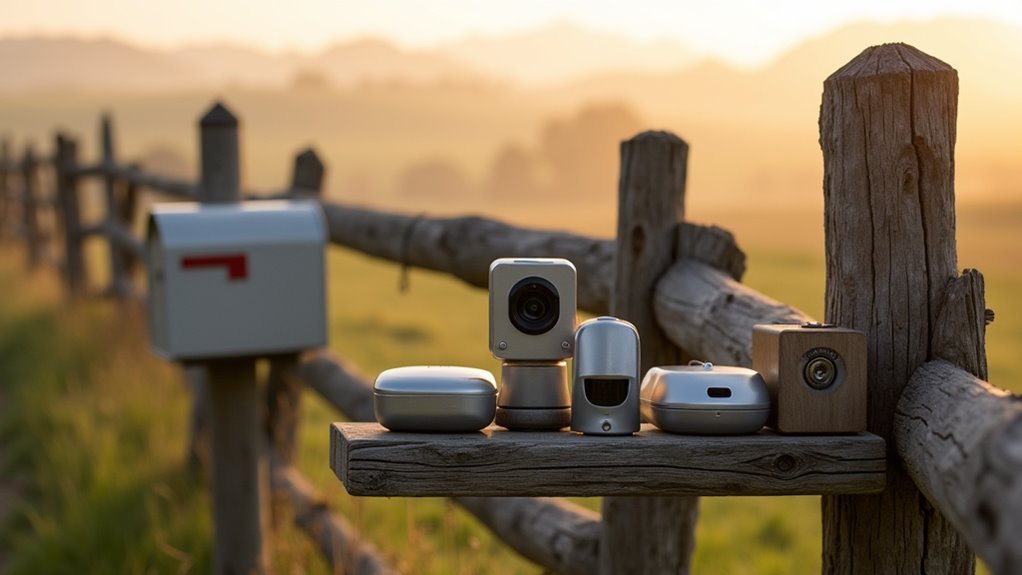You’ve probably wondered if connecting motion sensors to your Google Home is worth the investment. The answer lies in how this integration transforms your living space from a collection of smart devices into a truly responsive environment. When your motion sensors communicate with Google Home, they don’t just detect movement—they trigger a cascade of automated responses that can revolutionize your daily routines, security protocols, and energy consumption patterns in ways you haven’t yet considered.
Understanding Motion Sensor Technology and Smart Home Compatibility

When you’re setting up a smart home ecosystem, motion sensors serve as the invisible guardians that detect movement using technologies like Passive Infrared (PIR) and Active Ultrasonic sensors.
These devices become particularly powerful when you integrate them with platforms like Google Home, creating automated responses to detected presence.
Smart home integration transforms basic motion detection into intelligent automation that responds seamlessly to your daily routines and presence patterns.
For seamless integration, you’ll want motion sensors that support protocols like Zigbee or Matter. This compatibility guarantees your sensors communicate effectively with your smart home hub and Google Assistant.
Modern motion sensors offer adjustable sensitivity settings, letting you minimize false alarms from pets while maintaining security effectiveness.
The real advantage comes from linking these sensors with your existing smart home devices, enabling custom automation routines that respond intelligently to movement throughout your home.
Types of Motion Sensors That Work Best With Google Home
Choosing the right motion sensor makes all the difference in how smoothly your Google Home automation performs. The Aqara Motion Sensor P1 delivers exceptional compatibility with quick responsiveness, though you’ll need an Aqara Hub for operation.
For Zigbee setups, the Centralite Micro Motion Sensor works seamlessly across various hubs while maintaining reliable performance.
You can also consider the Hue Motion Sensor, which activates Google Home devices without requiring a Hue bridge. This flexibility supports diverse automated actions based on movement detection.
Matter-enabled options like the Eve Motion Sensor enhance cross-platform compatibility, making integration smoother.
These motion sensors excel at triggering automation routines—activating lights, security cameras, or other connected devices when they detect movement, greatly boosting your home’s security and convenience.
Enhanced Home Security Through Automated Motion Detection

When you integrate motion sensors with Google Home, you’ll transform your house into a smart security hub that responds instantly to detected movement.
Your system can automatically trigger real-time alerts to your smartphone, activate strategic lighting throughout your home, and start recording with smart cameras the moment motion’s detected.
This automated approach guarantees you’re immediately informed of any activity while creating multiple layers of deterrence and evidence collection without requiring your constant monitoring.
Real-Time Alert Systems
Once motion sensors connect to your Google Home ecosystem, they’ll transform your house into an intelligent security network that responds instantly to detected movement. You’ll receive real-time alerts directly on your smartphone whenever motion is detected in designated areas, keeping you informed whether you’re home or away.
These sophisticated home security systems automatically trigger responses like activating security cameras to start recording or turning on outdoor lights to deter potential intruders. You can also configure sensors to notify you when doors or windows open, adding vital awareness layers.
| Alert Type | Response Time | Peace of Mind |
|---|---|---|
| Motion Detection | Instant | Complete |
| Door/Window Opening | Immediate | Total |
| Camera Activation | Real-time | Maximum |
| Light Triggers | Instantaneous | Absolute |
Automated Security Lighting
Beyond instant notifications, your motion sensors can orchestrate a sophisticated lighting defense system that automatically illuminates your property when movement is detected.
This automated security lighting activates outdoor lights precisely when needed, enhancing visibility around your home’s perimeter and effectively deterring potential intruders.
You can configure your motion sensors to trigger specific lights during nighttime hours, providing immediate illumination that increases safety when you’re arriving home.
The system’s intelligence extends beyond basic activation—lights automatically shut off after predetermined periods of inactivity, conserving energy while maintaining security.
Your Google Home integration enables seamless coordination between motion sensors and other smart devices.
When movement triggers lighting, security cameras can simultaneously begin recording, creating an all-encompassing defense network that protects your property efficiently.
Smart Camera Activation
The seamless integration of motion sensors with your smart cameras creates an intelligent surveillance network that activates recording the moment movement is detected around your property.
This sophisticated motion detector system connects effortlessly with Google Home, transforming your smart devices into a thorough security solution. When movement triggers your sensors, cameras automatically begin capturing footage while sending instant alerts to your smartphone.
Your motion detector technology distinguishes between human movement and environmental factors like swaying branches, dramatically reducing false alarms. You’ll receive accurate notifications that warrant attention, ensuring captured footage remains relevant and actionable.
- Automatic camera activation upon motion detection for real-time surveillance
- Instant mobile notifications enabling immediate response to security threats
- Advanced filtering reduces false alarms from non-human movement
- Direct camera management through Google Home interface
- Visible deterrent effect discourages potential intruders
Streamlined Home Automation and Energy Management

When you integrate motion sensors with Google Home, you’ll transform your house into an intelligent ecosystem that automatically manages energy consumption and device control.
Motion detection triggers immediate responses across multiple devices – lights illuminate as you enter rooms and dim when you leave, while smart thermostats adjust temperatures based on your presence. This thorough energy management approach prevents wasteful heating or cooling of empty spaces.
Smart motion detection creates seamless automation, instantly adjusting lighting and climate controls while eliminating energy waste in unoccupied spaces.
You’ll create custom routines that activate several devices simultaneously, eliminating manual adjustments.
Motion sensors provide real-time occupancy data, helping you understand usage patterns and optimize energy consumption. When no motion is detected for predetermined periods, devices automatically shut off, minimizing unnecessary power drain and reducing utility bills while maintaining comfort.
Voice Control and Hands-Free Motion Sensor Management
While motion sensors excel at autonomous detection, pairing them with Google Home’s voice control capabilities elevates your smart home to unprecedented levels of convenience and accessibility.
You can seamlessly manage your entire motion detection system through simple voice commands, eliminating the need to manually check devices or navigate apps.
Google Assistant transforms how you interact with motion sensors, enabling intuitive communication with your home’s automation system.
You’ll experience truly hands-free control that responds instantly to your needs.
- Ask “Is there motion in the bedroom?” to check room occupancy before entering
- Command “Turn off motion detection in the kitchen” when cooking or entertaining
- Request motion sensor status updates while relaxing on your couch
- Create custom voice shortcuts for complex motion-triggered routines
- Monitor multiple rooms simultaneously through conversational queries
Creating Custom Routines and Automated Actions
Beyond simple voice commands lies Google Home’s most powerful feature: creating intelligent routines that transform your motion sensors into proactive home assistants. You can design custom workflows that trigger specific automated actions when movement’s detected.
Set up routines to automatically start security camera recordings, send instant notifications to your phone, or activate doorbell cameras when visitors approach your front door.
Your motion sensors can also control energy management by adjusting smart thermostats based on room occupancy, ensuring you’re not heating or cooling empty spaces.
Connect them with smart plugs to automatically power appliances when you enter rooms. Whether you want lights dimming for movie nights or coffee makers starting when you walk into the kitchen, these tailored responses streamline your daily routines while maximizing convenience and efficiency.
Real-Time Notifications and Remote Monitoring Capabilities
As your motion sensors detect activity throughout your home, Google Home’s notification system instantly alerts you through customizable push notifications sent directly to your smartphone.
You’ll receive real-time notifications whenever movement occurs, providing immediate awareness of what’s happening at home. The remote monitoring capabilities let you check sensor status from anywhere through the Google Home app, ensuring constant vigilance even during travel or work.
- Customize notification schedules to receive alerts only when you’re away from home
- Monitor multiple motion sensors simultaneously from a single dashboard interface
- Receive instant push notifications with timestamp details of detected movement
- Access historical motion data to review activity patterns and trends
- Control notification sensitivity settings to minimize false alarms from pets or routine movement
Seamless Integration With Other Smart Home Devices
Motion sensors become exponentially more powerful when they work alongside your existing smart home ecosystem through Google Home’s integration capabilities.
When you connect motion sensors to Google Home as your central smart hub, they’ll automatically communicate with security cameras, smart thermostats, and lighting systems to create thorough automations.
Detected movement can simultaneously trigger multiple responses: cameras start recording, lights illuminate pathways, and thermostats adjust temperatures. Your sensors work with voice assistants, door locks, and alarm systems, creating layered security protocols that respond intelligently to your presence.
Motion sensors orchestrate your entire smart home ecosystem, transforming simple movement detection into comprehensive automated responses across multiple connected devices.
This interconnected approach means you’re not managing individual devices separately. Instead, your motion sensors become part of a unified system where each component enhances the others’ functionality, delivering seamless automation that adapts to your lifestyle.
Setting up Motion Sensors With Google Home Assistant
Before you begin setting up motion sensors with Google Home Assistant, you’ll need an active Google Account linked to your smart home ecosystem.
You should also verify that your chosen motion sensor is officially compatible with Google Home, as not all devices work seamlessly with the platform.
These foundational requirements will determine whether your integration process runs smoothly or encounters frustrating roadblocks.
Google Account Requirements
Getting started with motion sensor integration requires a Google Account as your foundational step. Your Google Account serves as the central hub for managing all connected devices through the Google Home ecosystem. Without this account, you won’t be able to access the Google Home app or configure your sensors for automation routines.
Essential requirements for your Google Account setup include:
- Active Google Account with two-factor authentication enabled for security
- Google Home app installed and signed in with your primary account
- Administrative permissions to add and manage connected devices
- Consistent account usage across all Google services and devices
- Updated privacy settings allowing device data sharing and automation
Once you’ve established these account fundamentals, you’ll have the necessary foundation to connect and control your motion sensors effectively.
Device Compatibility Issues
While your Google Account provides the foundation for device management, compatibility challenges often emerge when connecting motion sensors to your Google Home system.
You’ll discover that Google Home currently offers limited support for motion sensors, creating frustrating restrictions in functionality and integration. Many users experience issues where only specific devices like door sensors gain recognition, while motion sensors remain unexposed to the platform.
These device compatibility issues stem from hub requirements that Google Home doesn’t universally support. Your motion sensor likely needs a compatible hub for operation, but not all hubs work seamlessly with Google’s ecosystem.
You’ll need to verify your specific sensor model’s compatibility and ascertain proper configuration, including room assignments and synchronization settings, to maximize integration success.
Matter Compatibility and Future-Proofing Your Smart Home
As smart home technology rapidly evolves, Matter compatibility has emerged as the gold standard for ensuring your motion sensors work seamlessly with Google Home and other platforms.
When you choose Matter-enabled motion sensors, you’re investing in a unified ecosystem that eliminates the frustration of device incompatibility.
Matter compatibility transforms how your smart home operates:
Matter compatibility revolutionizes your smart home by creating seamless device communication and eliminating frustrating connectivity barriers.
- Universal integration – Your motion sensors communicate effortlessly with Google Home and devices from different manufacturers
- Enhanced security – The Matter protocol provides robust, reliable communication standards
- Future-proof investment – New device releases won’t create compatibility headaches in your existing setup
- Expanded automation – You’ll enjoy greater convenience as your ecosystem grows
- Reduced connectivity issues – Say goodbye to frequent disconnections and setup problems
Troubleshooting Common Google Home Motion Sensor Issues
When your motion sensors aren’t showing up in Google Home or fail to integrate properly, you’re likely dealing with device recognition problems that stem from compatibility issues or incorrect setup procedures.
These integration failures often occur because Google Home has limited support for motion sensors, sometimes only displaying temperature readings instead of motion detection capabilities.
You’ll need to identify whether the issue lies with device assignment, missing room configurations, or fundamental compatibility barriers between your specific motion sensor and Google’s ecosystem.
Device Recognition Problems
Although motion sensors offer valuable automation capabilities, they don’t always integrate smoothly with Google Home due to recognition issues. Device recognition problems can greatly impact your smart home experience, leaving you frustrated when sensors won’t respond properly.
Common device recognition challenges include:
- Missing device type designation – Motion sensors lacking specific device classifications won’t be recognized by Google Home
- Limited functionality responses – Sensors may only provide temperature readings instead of motion status updates
- Sync failures requiring manual refresh – You’ll need to use “sync my devices” commands to restore proper integration
- Persistent ghost devices – Removed sensors may remain visible for up to 24 hours
- Room assignment conflicts – Unassigned sensors often go unrecognized or malfunction
These recognition problems require targeted troubleshooting approaches.
Integration Setup Failures
Beyond recognition issues, you’ll encounter integration setup failures that prevent motion sensors from connecting to Google Home in the first place.
These failures typically stem from hub connectivity problems. Most motion sensors require a compatible hub to communicate with Google Home, so verify your hub’s properly integrated first.
Room assignments can also cause setup failures. Motion sensors assigned to specific rooms in your smart home app mightn’t appear in Google Home.
Try unassigning them from rooms during initial setup.
When setup fails, use Google Home’s “sync my devices” command to refresh connections. This forces the app to rediscover your motion sensors.
Remember that Google Home currently offers limited motion sensor support, often detecting only temperature readings rather than motion status.
Privacy and Security Considerations for Motion Detection
While motion sensors greatly boost your home’s security capabilities, you’ll want to carefully evaluate the privacy implications of these devices before integration.
Your data’s protected through encryption and secure storage practices, with manufacturers guaranteeing no personal information gets sold to third parties. You’ll maintain control over your privacy through adjustable permissions and opt-out features.
Consider these essential security measures when integrating motion sensors:
- Enable two-factor authentication through compatible apps like Aqara for enhanced account protection
- Review and adjust data sharing permissions to limit information collection
- Utilize offline automation features to reduce internet-based vulnerabilities
- Monitor real-time alerts and notifications for unauthorized movement detection
- Verify encryption standards for all collected account and location data
These precautions guarantee your enhanced security doesn’t compromise your personal privacy.
Cost-Effective Smart Home Solutions and ROI Benefits
You don’t need to break the bank to start automating your home with motion sensors, as these devices typically cost just $15 to $30 and offer an accessible entry point into smart home technology.
Once installed, you’ll see immediate energy savings of up to 30% on your utility bills through automated lighting and temperature adjustments based on room occupancy.
Your investment pays dividends beyond monthly savings, with smart home features increasing property values by 5% to 10% while potentially reducing insurance premiums by up to 20%.
Affordable Automation Starter Options
Since home automation doesn’t require a massive upfront investment, motion sensors paired with Google Home offer an ideal entry point into smart living. You can start small and expand gradually, testing automation benefits without breaking your budget.
The Aqara Motion Sensor P1 exemplifies affordable reliability at around $25, providing seamless Google Home integration. You’ll automate routine actions like lighting control, potentially reducing energy consumption by up to 30%.
This DIY-friendly approach eliminates monthly fees while delivering immediate convenience and security improvements.
Consider these starter automation possibilities:
- Automatic hallway lighting when you walk through at night
- Kitchen lights activating as you enter for morning coffee
- Security alerts sent to your phone when motion’s detected
- Living room lamps turning on at sunset
- Bedroom fan activation during nighttime movement
Energy Savings Through Automation
Beyond these immediate conveniences, motion sensor automation delivers measurable financial returns through reduced energy consumption.
You’ll see electricity bills drop by 15-25% as smart lighting systems automatically adjust based on occupancy, ensuring lights aren’t left on in empty rooms.
Motion sensors optimize your HVAC system by detecting presence and adjusting temperature settings accordingly, potentially reducing heating and cooling costs by 10-30%.
The financial benefits compound through automated routines that power down devices when rooms are unoccupied.
You can achieve energy savings that often generate a 200% return on investment within the first year.
Long-Term Investment Value
While energy savings provide immediate cost reductions, the true financial advantage of motion sensor integration lies in its long-term investment value that extends well beyond monthly utility bills.
When you invest in motion sensors and home automation, you’re building equity that pays dividends for years. Smart motion sensors like the Aqara Motion Sensor P1 offer five-year battery life, virtually eliminating replacement costs.
Your property value increases as buyers actively seek smart home features, making your investment profitable at resale.
- Enhanced property marketability with modern smart home technology
- Potential home insurance premium discounts for improved security systems
- Minimal maintenance costs with long-lasting sensor batteries
- Increased resale value through attractive automation features
- Time savings and productivity gains from optimized daily routines
Optimizing Motion Sensor Placement and Sensitivity Settings
When you’re setting up motion sensors for your Google Home integration, strategic placement determines whether your automation system works flawlessly or constantly frustrates you with missed triggers and false alarms. Install your motion sensors 6-8 feet high, angled toward doorways and pathways where movement naturally occurs. This positioning maximizes your 20-40 foot detection range while minimizing blind spots.
| Setting | Recommendation | Benefit | Consideration |
|---|---|---|---|
| Height | 6-8 feet | Ideal detection angle | Avoid ceiling fans |
| Sensitivity | Adjustable for pets | Reduces false alarms | Test with household activity |
| Distance | 20-40 feet range | Covers large areas | Multiple sensors for gaps |
| Coverage | Overlapping zones | No detection gaps | Include temperature sensor areas |
You’ll need to adjust sensitivity settings and test regularly to fine-tune performance for your specific environment.
Frequently Asked Questions
Why Did Google Discontinue Google Home?
You’ll find that Google discontinued Google Home because they wanted to streamline their product lineup and focus on enhanced Nest devices that offer better sound quality, displays, and improved smart home integration capabilities.
What Is the Purpose of a Motion Sensor?
You’ll use motion sensors to detect movement in designated areas through infrared or microwave technology. They’ll trigger security alarms, activate smart lighting, adjust thermostats, and start camera recordings automatically when they sense your presence.
How Does Google Nest Detect Motion?
Google Nest detects motion using Passive Infrared sensors that sense heat changes from moving warm bodies. You’ll also get computer vision algorithms that differentiate between people, pets, and objects for accurate identification.
Should I Allow Motion Sensors?
You should allow motion sensors if you want automated lighting, enhanced security alerts, energy savings, and convenient routines. They’ll make your home smarter and more responsive to your daily activities.





Leave a Reply